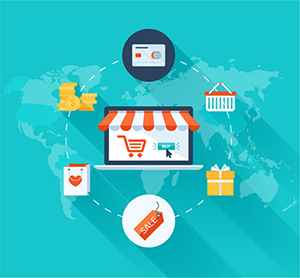 Editor's Note: Raanan Cohen is Co-Founder and CEO of Bringg, a customer-centric logistics technology platform for enterprises, with customers in more than 50 countries including some of the world's best-known brands.
Editor's Note: Raanan Cohen is Co-Founder and CEO of Bringg, a customer-centric logistics technology platform for enterprises, with customers in more than 50 countries including some of the world's best-known brands.
2017 was an important year for delivery logistics. With ecommerce sales reaching $23 trillion in annual sales worldwide, customers are relying on better and faster deliveries for all sort of goods and services. But this evolution in the supply chain, and for last mile fulfillment in particular, doesn't end with retail. From restaurant chains to supermarkets to pharmacies to service providers, the world of logistics is experiencing unprecedented change.
The volume of parcels and services delivered to people's doorsteps is only going to keep growing, with significant implications for businesses, cities, and established delivery businesses. In the US alone, the B2C parcel delivery market is expected to be worth nearly $50 billion by 2019, up from $35 billion in 2015!
This radical shift in customer behavior and expectations regarding deliveries means that many organizations will have to remake their entire supply chain in order to become more agile, and remain competitive in a world where an optimized, lean and efficient logistical infrastructure is at the core of a successful customer-centric business.
These are some of the key industry trends in delivery logistics and supply chain management which will take center stage in the upcoming year:
1. Real-time Visibility
We're moving towards a supply chain which is fully transparent and trackable in real-time. On the one hand, it's helping companies become more efficient by knowing the precise status of each order, driver and customer. On the other hand, customers are always aware of the status of their purchase and have the ability to interact with their driver directly if need be.
But transparency can go far beyond efficiency, comfort and value. Customers are increasingly demanding and worried about the supply chain behind their purchases. As Andrew Marder points out, the definition of transparency is expanding, with customers increasingly aware of factors such as worker rights issues, environmental impact, and even political affiliations.
2. Big Data
From the millions of data points and variables in any supply chain should come the knowledge required to determine business strategies and to support decision-making processes. And the puzzle isn't getting any simpler, with companies deploying different tech platforms and using multiple fleets and 3PLs throughout their supply chain. In addition, there is the data collected at customer touch points, from feedback on the delivery to driver ratings. All this information needs to be processed and analyzed since the “brand experience” doesn't only apply to brick and mortar establishments anymore - and companies are increasingly coming to realize that the delivery process is a powerful catalyst to improving or swaying brand perceptions.
In the context of the supply chain for most businesses, big data and predictive analytics are still an untapped resource that can potentially provide insights which help anticipate or respond to events or disruptions. Unpredictable consumer behaviour, traffic or weather patterns, and labour unrest are all external events that can disrupt a supply chain and lead to increased costs and customer service challenges. Big data can help organisations become better trading partners to their customers and suppliers. But before insights and analytics can be leveraged for a better supply chain, there's a huge task at hand for the many organizations that need to first collate data points from all sources and align them to their business operations.
3. Sharing Economy
Sharing economy solutions will soon begin disrupting logistics services. We're already seeing how Uber and other companies setup driver networks to deliver packages to consumers by using their personal vehicles. To cope with the shortage of drivers and with the need for flexible fleets that are available based on business demand, the sharing economy will begin spreading in 2018 into big brands that need to find alternatives that help them create a more flexible and adaptable logistics infrastructure.
This trend can take different shapes and forms. For example, earlier this summer WalMart piloted a scheme in which some of their store staff could earn extra cash by delivering packages to customers on their drive back home. Other companies are looking into different solutions that would enable them to share resources and fleets in order to become more efficient - for instance, a restaurant fleet with spare time after lunch rush hour could potentially help a retailer struggling to meet demand during the peak holiday season.
4. Conquering the Last Mile
Amazon has changed the way we buy things. If retailers don't offer two-day or overnight shipping, shoppers will likely go elsewhere. This is putting an unprecedented level of pressure on the entire ecosystem, and what used to be a challenge for retailers is now something that many other industries need to take into consideration. As Business Insider said, it will be about Amazon versus the World following their acquisition of Whole Foods.
The last mile challenge isn't only about logistics feasibility and speed, but also about the strain that the now de facto delivery alternatives put on profit margins. That's why businesses will need to get creative when it comes to finding new ways to pull together their resources and fleets in order to build new supply chain models that help them conquer the last mile and win their share of customer wallets.
5. Orchestrating Delivery Channels
While the spotlight right now is on the Last Mile, there’s a lot of room for growth, improvement and modernization throughout the entire supply chain - from the first mile to the last and everywhere in between. One of the biggest challenges for companies is that the last mile matrix is getting increasingly complex with all the different delivery channels. In order to succeed, retailers will have to orchestrate their logistics matrix strategically, optimizing the use of all the delivery channels depending on their customers’ location, required level service, price, etc. To do this, they will have to increase their investment in technology - using the platforms and tools to seamlessly align and manage the entire jigsaw efficiently.
While in the past, the only decision businesses had to make was whether to use an in-house fleet or an outsourced delivery partner, the reality for many companies today is that they have to manage multiple 3PLs, fleets, and even crowd-sourced drivers. The current landscape will continue forcing businesses to be open to new ‘hybrid’ logistics models using a combination of delivery companies, technologies, and distribution partners to serve an increasingly demanding and global customer base.
6. Openness to the unknown
The world is changing fast, and it is key to be able to rapidly react to industry changes and to new technologies that we might not even have heard of yet. So those companies that stay with their finger on the pulse and with an open mind when it comes to rethinking the way they work, will be the ones that succeed in the long run.
There was incessant press coverage in 2016 about drone deliveries. During 2017 the attention shifted towards self-driving cars and trucks. With the recent explosion of Bitcoin value and blockchain technologies, there is a lot of speculation and ideas about how to leverage blockchain protocol to improve supply chains. But the success and implementation of all these technologies remains to be seen.
I look forward to another year where reality often exceeds what not long ago felt like fiction - constantly creating new milestones and standards that move the entire ecosystem forward with groundbreaking innovation in technology, commerce and logistics.
SC
MR


Latest Supply Chain News
- Tech investments bring revenue increases, survey finds
- Survey reveals strategies for addressing supply chain, logistics labor shortages
- Israel, Ukraine aid package to increase pressure on aerospace and defense supply chains
- How CPG brands can deliver on supplier diversity promises
- How S&OP provides the answer to in-demand products
- More News
Latest Resources

 Explore
Explore
Latest Supply Chain News
- Tech investments bring revenue increases, survey finds
- Survey reveals strategies for addressing supply chain, logistics labor shortages
- Israel, Ukraine aid package to increase pressure on aerospace and defense supply chains
- How CPG brands can deliver on supplier diversity promises
- How S&OP provides the answer to in-demand products
- AI, virtual reality is bringing experiential learning into the modern age
- More latest news
Latest Resources

Subscribe

Supply Chain Management Review delivers the best industry content.

Editors’ Picks





